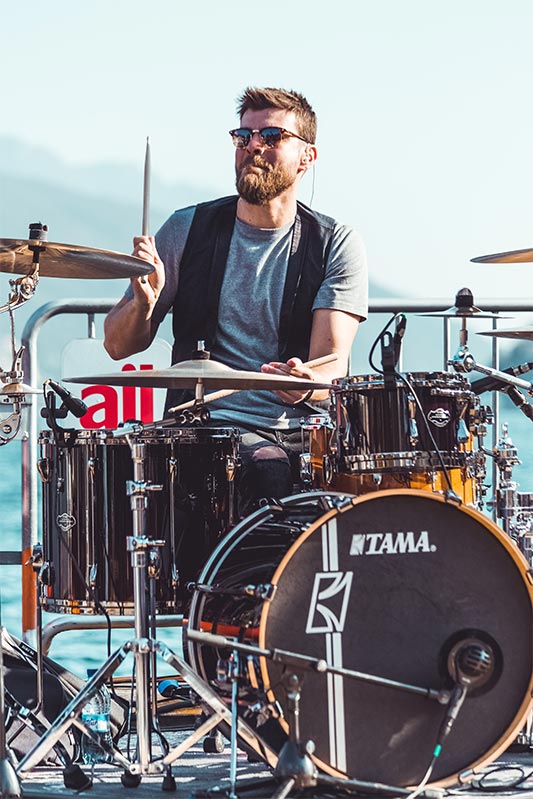If you’ve gone to a live show before, there’s a chance you might have noticed that the performers have something in their ears, an earbud of some sort. So why do musicians wear these earpieces when they perform? Well, when it comes to performing live, it’s very important that the singers and other musicians on stage can hear their own music.
A common way to do so is to set up speaker/wedge monitoring. They’d be set on stage, facing towards the performers so the audience won’t be able to hear them over the other speakers. However, In-Ear Monitors (IEMs) are becoming popular choices for many musicians who perform live. Instead of having a bunch of stage monitors/speakers taking up performance space, musicians can hear their own mix from an earpiece. It’s definitely much easier and more convenient for musicians to wear earpieces to monitor their sound. With more benefits and convenience, it’s no wonder that musicians wear these earpieces instead of relying on on-stage monitors.
Table of Contents
What are In-Ear Monitors (IEMs)?

You will see singers and musicians wear these special earpieces accompanied by what looks like a radio attached to their belt. A complete in-ear monitor system will consist of the earpieces, the transmitter, and a body-pack receiver. These receivers can only receive audio from one transmitter, however, transmitters can broadcast to multiple receiver packs. This allows several people to listen to the mix.
Transmitters are usually placed in a rack on the side of the stage, close to the mixer. The mixer is what is used to balance each instrument on stage. It also feeds the audio to the transmitters with an aux send. The body-pack receiver is commonly clipped to the performer’s belt. You then plug in the earpieces directly to the receiver and you’re good to go.
Benefits of Using In-Ear Monitors
Easier to Travel and Perform With
A big reason why musicians should use in-ear monitors is they’re easier to travel and perform with. You won’t have to lug around big speakers/wedges to your gigs. Now you’ll have more space in your car to fit all of your instruments and other pieces equipment.
Having stage monitors can also contribute to a messy stage, limiting the performers by making it harder to move around. There will be more wires on stage with the speakers, which can be potential tripping hazards. You can focus more on giving a good performance instead of watching for wires and speakers that you can trip over. This allows performers to take full advantage of the stage/space they’re given.
Overall, switching over to in-ear monitoring makes everything much easier, from the set-up to the performance, and putting everything away afterward.
Higher Sound Quality
When it comes to audio equipment, sound quality is always going to be a priority. Using stage monitors introduces potential issues that you might run into. These speakers are only meant to be heard by the performers on stage, however, these monitors can cause feedback.
They can also create phase issues that take away from your music’s sound, reduces production quality. Using IEMs helps prevent these problems from occurring, eliminating live audio problems at the source.
The sound quality you get from using in-ear monitoring is great. It will be much clearer since your sound will be directly monitored through the earpieces you wear.
Safer for Your Hearing
Protecting your hearing should be one of your main priorities as a musician. We’re constantly surrounded by high volume levels, especially when we’re performing on stage. Stage monitors are loud so we can hear them while we play.
If you’ve ever played a live show or attended a concert, you probably have experienced some type of ringing in your ears before. Normally this ringing would go away in a day or two, however, your ears being exposed to this kind of environment every night has it’s long term effects.
You won’t have to worry about it when using in-ear monitors. The noise-canceling earpieces that you wear not only make it easier to hear the mix, they also protect your hearing at the same time. As performing musicians, we have to accept that these loud environments are part of the lifestyle. It’s up to us to take necessary action in keeping our hearing safe.
Wired vs Wireless
We highly suggest that you consider spending a little more to get a wireless IEM system. Again, one of the biggest benefits of using in-ear monitoring is having more freedom on stage. Going wireless allows you to use IEMs to its full potential. This is most important for the performers on stage who are going to be moving around a lot (singers, guitarists, bassist).
For drummers and keyboardists, you might not need the benefits that come from a wireless IEM system as much. Your role requires you to be more stationary on stage, so you can save money on having a wired system instead.
Should I Go for a Custom Fit?
You have two options when it comes to the earpieces that you’ll be using with your IEM system. There are generic fitting and custom molded ear monitors. While you can definitely make earpieces with a generic fit work for you, keep in mind that everyone’s ears are shaped differently. If your earbud doesn’t fit properly, there’s a chance of it falling out your ear while performing.
If you have the extra money in your budget, we highly recommend that you get custom sized earpieces for your in-ear monitoring system. This does require you to see an audiologist to have a mold of your ear canal made. You will have to wait longer to get your custom earpiece produced. It’s definitely worth it as you’ll get a perfect fit that you won’t have to worry about.
These earpieces will be designed to specifically fit your ears. They’ll be more comfortable to wear and will stay in your ears during the entire performance.
Custom molded earpieces use to be very expensive back in the day, however, nowadays you can find more affordable options.
Potential Things to Look Out for
Interference (Wireless IEM System)
This is mainly for those who decide on using wireless IEM systems as they can suffer from interference issues. The reason for this is because they use radio waves to transmit the sounds between the mixer and the receivers. Because of this, your wireless in-ear monitoring system is prone to audio dropouts and reduces sound quality.
While interference can be concerning, technology has gotten a lot better over the years. Nowadays, most systems use dedicated signals that lock the transmitter and receiver to the same frequency. This helps ensure that audio quality is good and consistent. Just keep in mind that you might notice a small reduction in audio quality from your earpiece. Considering all of the other benefits of using a wireless IEM system, it’s not the worst thing to deal with.
Easy to Misplace
One of the best things about in-ear monitoring systems is its portability and size compared to on-stage monitors. However, you should be extra careful as they’re easier to misplace. These small earpieces don’t distract the audience thanks to their design. to not be distracting to the crowd. They’re great until you misplace it somewhere.
Also, there’s always the chance of them falling out of your ear while you perform. You would never want that to happen, especially in the middle of a song. To combat this problem, get custom fit earbuds that will be perfectly shaped for your ear canal. If you think you’re earpieces will easily fall out of ears with generic fits, definitely consider paying more to get a custom fit set.
Feeling Distant from the Audience
Using an IEM system can make you feel distant from your audience. Music venues are very loud, but not just because of the performers. The crowd contributes a lot of the energy too. Since in-ear monitors have noise-cancelation features, it’s harder to hear the crowd. They could be cheering you on, but you wouldn’t be able to hear it.
This can make performers feel disconnected from their audience, something you’d never want. Establishing a connection with the crowd is one of the best feelings in the world. It definitely motivates you to keep performing to your best abilities on stage.
You can face a microphone towards the audience to solve this problem. This mic will be able to capture the ambiance of the crowd, adding a little extra to the monitor mix. Even if you’re using noise-canceling earbuds, you’ll connect with the crowd.
Final Thoughts
In-ear monitoring is a great way to monitor the sound of your music while you perform on stage. You will be freer to move around while you perform while also protecting your ears from loud volume levels. If you’re still using on-stage monitors, we definitely recommend that you check out IEM systems. Performers who love to move around will greatly benefit from switching over to in-ear monitoring. Now you know why some musicians wear earpieces during their performances. If you’re a musician yourself who performs, maybe you’ll give it a try too. We hope this article helped you develop a better understanding of IEM systems.






Leave a Comment